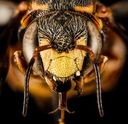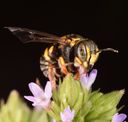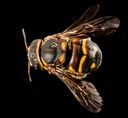Leafcutter, Resin, Mortar, Sharptail, Mason, and Woolcarder bees and relatives
Megachilinae
Classification
- Phylum: Arthropoda
- Subphylum: Hexapoda
- Class: Insecta
- Order: Hymenoptera
- Family: Megachilidae
- Subfamily: Megachilinae
Pronunciation
How to pronounce Megachilinae: //ˌmɛɡəˈkɪlɪniː//
These audio files are automatically generated. While they are not always 100% accurate, they are a good starting point.
Images






Summary
Megachilinae is a diverse subfamily of bees within Megachilidae, consisting of various species known for their unique nesting behaviors and important role in pollination.
Physical Characteristics
Members of the Megachilinae subfamily have diverse physical traits depending on their specific classifications. They typically possess robust bodies, with some species exhibiting specialized adaptations such as strong mandibles for cutting leaves in leafcutter bees.
Identification Tips
Identification of Megachilinae can involve examining body size, hairiness, and the shape of their mouthparts. Leafcutter bees are known for their characteristic round or oval-shaped bodies and their unique behavior of cutting leaves.
Habitat
Megachilinae are commonly found in a variety of habitats, including gardens, meadows, forests, and urban areas, often nesting in pre-existing cavities or creating nests from plant materials.
Distribution
This subfamily has a global distribution, with species found in various regions across all continents except Antarctica.
Diet
Megachilinae primarily feed on nectar and pollen, which they collect from flowering plants. Some species are specialized for certain types of flowers.
Life Cycle
Typically, Megachilinae undergo a complete metamorphosis with distinct egg, larva, pupa, and adult stages. Most species are solitary, with females constructing their nests and provisioning them with food.
Reproduction
Reproduction usually involves solitary nesting behavior, where females lay eggs in the constructed nests and provision them with pollen and nectar for the developing larvae.
Predators
Common predators of Megachilinae include birds, other insects, and small mammals that may raid their nests.
Ecosystem Role
Megachilinae are important pollinators for a wide variety of flowering plants, thus playing a crucial role in maintaining healthy ecosystems and supporting biodiversity.
Economic Impact
As pollinators, Megachilinae contribute significantly to agriculture and horticulture, enhancing crop yields of fruits and vegetables that depend on insect pollination.
Evolution
Megachilinae belong to an ancient lineage of bees that has diversified significantly over time, adapting to a range of ecological niches and floral resources.
Similar Taxa
Misconceptions
There are misconceptions that all bees are honey bees; in reality, Megachilinae includes many solitary species that do not produce honey or live in colonies.
Tags
- Bees
- Megachilidae
- Pollinators
- Ecology